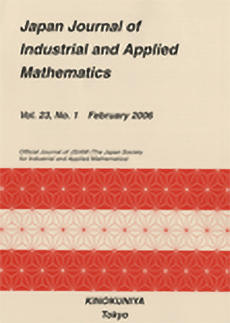Abstract
It is known that Turing systems in two dimensions produce spotted, striped, and labyrinthine patterns. In three dimensions, a greater variety of patterns is possible. By numerical simulation of the FitzHugh--Nagumo type of reaction-diffusion system, we have obtained not only lamellar, hexagonal and spherical structures (BCC and FCC) but also gyroid, Fddd, and perforated lamellar structures. The domains of these three structures constitute interconnected regular networks, a characteristic occurring in three dimensions. Moreover, we derive the Lyapunov functional by reducing the system, and we evaluate this functional by introducing the asymptotic solutions of each structure by the mode-expansion method and direct simulation of the time evolution equation.
Citation
Hiroto Shoji. Kohtaro Yamada. "Most Stable Patterns among Three-Dimensional Turing Patterns." Japan J. Indust. Appl. Math. 24 (1) 67 - 77, February 2007.
Information




